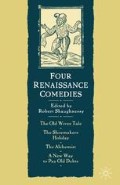Abstract
In terms of its plot, The Old Wives Tale fully confirms the promise of its title, which, besides acting as a marker of the play’s implausible and inconsequential quality, is also an accurate definition of what it actually is: a tale of romance, fantasy, magic and adventure told by a old woman to while away a dark winter’s night. Three pages, Antic, Frolic and Fantastic, abandoned by their (possibly) newly-wed master and left to wander miserably through a forest, happily stumble into the house of a Smith. Inviting them to taste of the comforts of a barking dog, ‘a good fire to sit by’ (1.41), pudding and cheese, and hot spiced ale, the Smith introduces them to the Old Woman, the wife of the title; the pages clamour for ‘a merry winter’s tale’ which ‘would drive away the time trimly’ (1.70). As the Smith coaxes one of the pages offstage to take an ‘unnatural rest’ in a shared bed, the Old Woman embarks upon a rambling account of ‘a king, or a lord, or a duke that had a fair daughter’, of ‘a conjurer’ who ‘turned himself into a great dragon and carried the king’s daughter away in his mouth’ (1.102–3) to a stone castle, and of her two brothers sent in pursuit. Before she can go any further, the brothers themselves materialise onstage; the Old Woman’s narrative within drama dissolves into a play within a play.
Preview
Unable to display preview. Download preview PDF.
Further reading
Ashley, Leonard R. N., George Peele (New York: Twayne, 1970).
Binnie, Patricia (ed.), The Old Wives Tale, The Revels Plays (Manchester: Manchester University Press, 1980).
Jackson I. Cope, ‘Peele’s Old Wives Tale: Folk Stuff into Ritual Form’, ELH, 49 (1982), 326–38.
Ewbank, Inga-Stina, ‘“What words, what looks, what wonders?”: Language and Spectacle in the Theatre of George Peele’, The Elizabethan Theatre, 5 (ed.) G. R. Hibbard (Toronto: Macmillan, 1975).
Hook, F. S. (ed.), The Life and Works of George Peele (New Haven: Yale University Press, 1970).
Marx, Joan C., ‘“Soft, Who Have We Here?”: The Dramatic Technique of The Old Wives Tale’, Renaissance Drama, New Series, 12 (1981), 117–44.
Viguers, Susan T., ‘The Hearth and the Cell: Art in The Old Wives Tale’, Studies in English Literature, 21 (1981), 209–21.
Whitworth, Charles (ed.), The Old Wife’s Tale, New Mermaids (London: Ernest Benn, 1996).
Editor information
Copyright information
© 2004 The Editor(s)
About this chapter
Cite this chapter
Peele, G. (2004). The Old Wives Tale. In: Shaughnessy, R. (eds) Four Renaissance Comedies. Palgrave, London. https://doi.org/10.1007/978-1-4039-3886-2_1
Download citation
DOI: https://doi.org/10.1007/978-1-4039-3886-2_1
Publisher Name: Palgrave, London
Print ISBN: 978-0-333-97366-0
Online ISBN: 978-1-4039-3886-2
eBook Packages: Palgrave Literature & Performing Arts CollectionLiterature, Cultural and Media Studies (R0)

